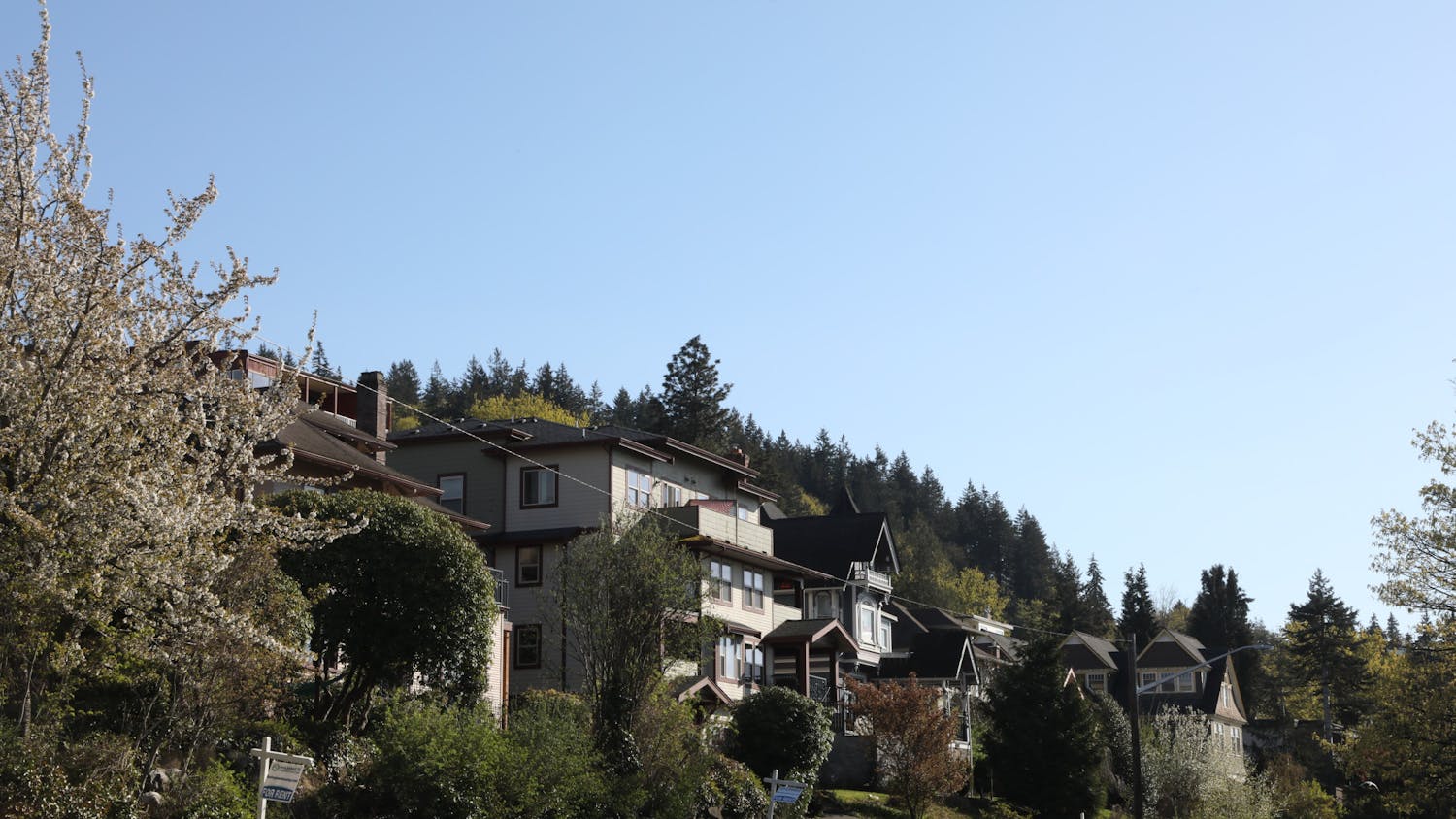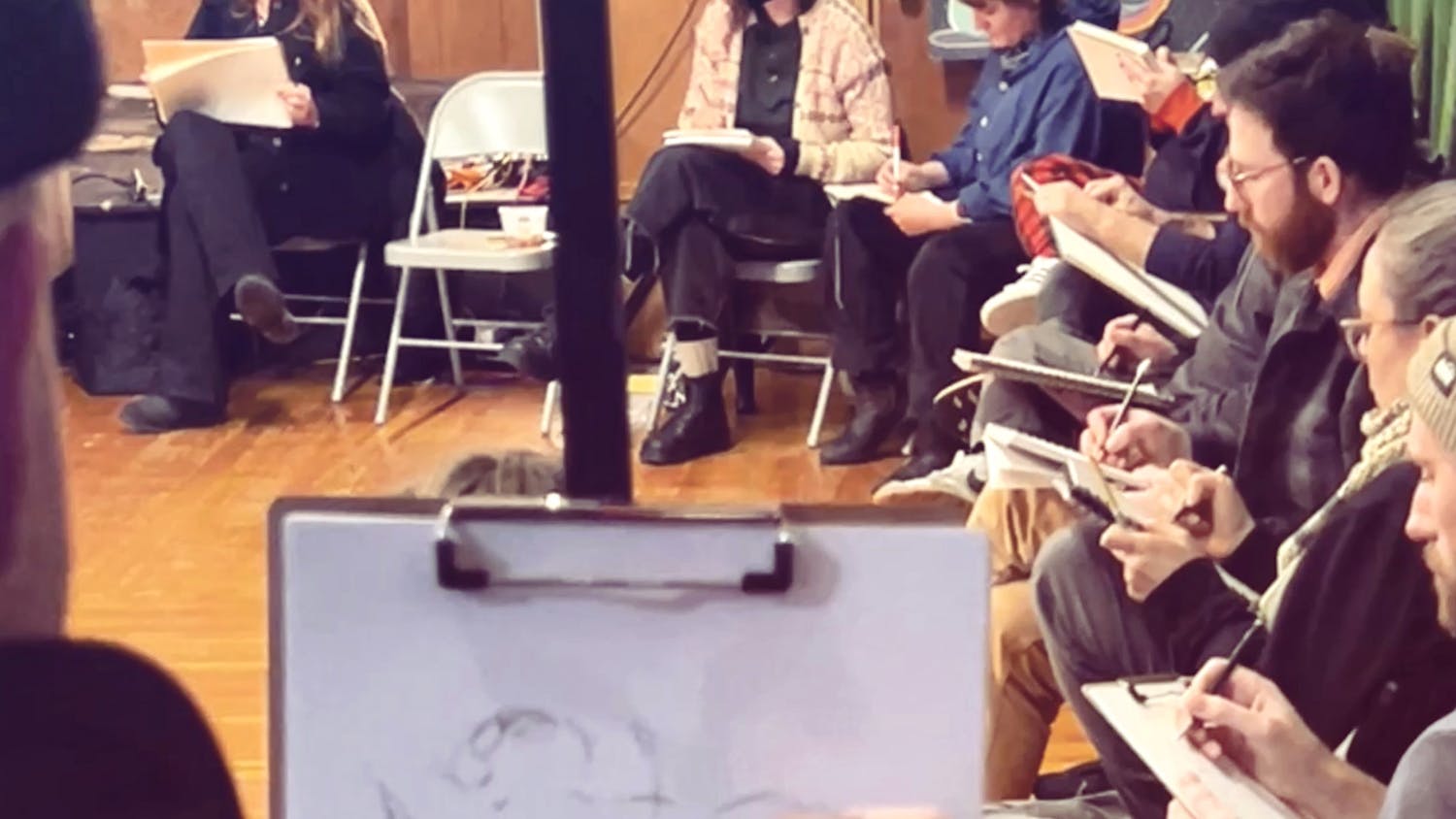Sam Bowman (left) works on an independent project amongst peers in a main area of the Makerspace in downtown Bellingham on July 20, 2018. // Photo by Kelly Pearce
By Jaya Flanary
A warm breeze flows in through the large opening of the garage door. The space has high ceilings and an open floor plan with woodworking materials and equipment. A side door leads to a smaller, air-conditioned room full of technology. 3D printers are methodically moving back and forth, creating.
Mary Elliott, founder and executive director of the Bellingham Makerspace, walks room to room showing everyone a fake bomb that was made earlier that week. The device’s red numbers count down as it beeps, just like a movie.
Other projects clutter the area: Elliott’s LED matrix cube changes color, 3D printed statues are displayed on the table and members tinker with their current projects.
Elliott is a pediatric occupational therapist. Years ago, she used a 3D printer to create a pinky splint for a 2-year-old girl. The splint had to be designed so the child couldn’t pull it off.
“I ended up making a little pinky splint, sort of like a little canoe, that slid on like jewelry. I put a bird on it and made it pink,” she said.
She found 3D printing to be easier than one would think.
“If there was a place where people could go and learn and have a mentor as they’re working on [something], then that removes one of the barriers to trying,” Elliott said. “This technology is not the future, it’s right here, right now."
The global maker movement started when Massachusetts Institute of Technology professor Neil Gershenfeld created a class called “How to make (almost) anything)” which led to MIT’s Fab Lab, a global network that provides experts in the STEM field. The Bellingham Makerspace is connected to this lab.
Founded in 2013, the Makerspace is a nonprofit organization that offers the tools and education to anyone wanting to make something. The organization shares a building on the marina with Western and Bellingham Technical College. The tool library includes multiple 3D printers and Computer Numerical Control (CNC) machines, as well as woodworking tools, T-shirt design printers, soldering kits, 3D scanners, sewing machines, laser machines and more.
Using some equipment requires safety certification, which the Makerspace offers through educational classes and events. Monthly memberships, including a student-discounted one, are available to those who want to use the equipment. The organization is always looking for volunteers.
Youth education is a passion of Elliot’s because she works in pediatrics, so the Makerspace offers many programs for kids. Though the technology is here now, the education system hasn’t caught up to it, Elliott said.
The organization offers professional development for teachers to get hands-on experience and lesson plans to bring back to their classrooms.
“I feel like this space makes things possible,” Elliott said. “By taking the fear and the cost out of trying something new and showing people what’s possible.”
Elliott’s favorite project she helped with was an LED edge lit sign for a Warehouse 420 show, which Snoop Dogg performed at.
BTC students created a robot named Sammy, made up of 314 3D printed parts, for their Capstone Project. Sammy has a head, torso and right arm and is able to answer questions the way Siri does. The students aim to complete Sammy and put the robot on campus to answer school-related questions.
Other Makerspace projects have included turning a school bus into a tiny home, updating a ‘60s trailer, 3D printing a full-size bicycle and electric cello, and an interactive map that Kindle used for advertising. Members have also made things for businesses, such as light-up signs for Aslan Brewing Company.
“The members that we have have such a wide array of interesting skills,” Elliott said.
Meet the Makers

Jeremiah McCoy
Jeremiah McCoy has a background in mechanical aerospace testing, so he has rocket scientist credentials. McCoy spends a lot of time at the Makerspace, where he can be found tinkering with his small inventions like a cell phone tripod.
McCoy was approached by casino workers looking to make a poker table that dealt cards automatically. McCoy started to design the table at the Makerspace in October.
The table, which is almost completed, has been a complicated project.
“Because it was much more elaborate, it really pushed my boundaries of what I already knew how to do versus what I needed to learn how to do in order to finish the project,” he said.
He also teaches the Junk Drawer Robotics Youth Program for elementary school kids at the Makerspace. They learn things like coordinates, rotating versus sliding, leverage, hydraulics and more.
“Seeing how the kids just kind of lit up, it really just reminded me of what I used to do when I was in elementary school,” he said.

Melody Leroy
Melody Leroy met Mary Elliott when the Makerspace was at its old location on Forest Street. “She was just great. I just want to emphasize that so much, because that actually got me going,” she said.
Leroy joined as a member in October and started making a wall sconce out of wood. She first got safety certified with the woodworking equipment, which she thought was a huge learning curve.
“They told me at one point that I had logged in more hours than anybody else," she said.
Her sconces are battery-operated and have LED lights. One uses an on and off push button and the other uses a remote control. Nine months after Leroy became a member, she put the sconces up for sale at the Artwood Gallery in Fairhaven.
“I’ve had so many ideas over the years, and that’s why this is just the perfect place,” Leroy said. “You get the answers there and they figure out how to make it happen.”
Leroy thinks the Makerspace is a good asset to the community to show people that everyone is creative by providing them with the tools.
Shaun Baumchen
Shaun Baumchen moved to Bellingham from Bonney Lake, Washington in early June. He graduated from Montana State University with a Bachelor’s in engineering and a minor in mechatronics and mathematics.
Montana State has a makerspace, so he was familiar with the concept. In school, he learned how to use Arduino, a company that makes microcontrollers that are easy to use.
“Basically it’s a hardware accessory for electronics that [allows you to] write code and program the board, and then the board will tell outputs to do things,” he said.
Baumchen is creating lectures to teach members how to use Arduino by building robots that don’t hit walls.
He thinks the Makerspace brings people together from the community and from the STEM field.
“The only time I’ve seen a makerspace is in a university, but I think they should be more than just that because people can learn so much from a makerspace,” he said.

Arti Vachs
Arti Vachs learned about the Makerspace during a Seattle maker convention fair. It was one of the reasons he decided to move to Bellingham, Vachs said.
Vachs, now a volunteer, is most interested in 3D printing as a hobby and future career. He calibrates the printers and helps people use them. A lot of his 3D prints are displayed at the Makerspace.
“[A 3D printer] a box that makes toys and it’s really cool. It’s very much an emerging technology that has a lot of potential,” Vachs said.
3D printing now uses many materials which allow you to make different items. Vachs makes his prints more vibrant by adding things like antique lacquer to wood to give it texture.
“Before I came here it was really hard for me to socialize,” Vachs said. “I just did not know how to reach out to people and when I came here I felt like I belonged immediately and had a group of very positive people that were willing to help me out and to help me learn.”
 Ryan Smith-Roberts
Ryan Smith-Roberts
Ryan Smith-Roberts describes himself as a computer geek.
“I do more of the software stuff and was playing with the CNC for a while,” he said.
A CNC is a three-axis router, according to Smith-Roberts, with a bit that always points downward and moves in three dimensions allowing you to put three-dimensional carvings into materials.
Smith-Roberts now volunteers for the Junk Drawer Robotics Youth Program.
“The community here is much nerdier than pretty much anywhere in Bellingham that you can go to that’s not an actual school, and that’s really nice,” he said.
The Makerspace recently acquired the upstairs loft and stacked 14 computers for a computer cluster that Smith-Roberts is working on, which he compared to Apple’s Cloud. The machine in the middle is called the master, and the surrounding machines are called servants.
Smith-Roberts thinks the Makerspace is unique.
“We have tools here that regular people would never get access to,” he said.






